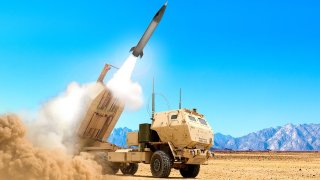A Lockheed Martin Precision Strike Missile Just Made Some 'History'
According to the company, a Precision Strike Missile (PrSM) was fired from a HIMARS launcher to hit a target set. The test was the shortest distance flown to date, demonstrating the system's continued accuracy from launch to impact.
When it comes to missiles, many tests are set to break records – truly going the distance. However, this week aerospace and defense giant Lockheed Martin announced that it had successfully completed a production qualification flight test with the U.S. Army in a demonstration at White Sands Missile Range, New Mexico.
It didn't set out to highlight the increased range, however. Rather this was even noted to be the "shortest-range flight test." Sometimes longer isn't better – and it is accuracy that is important.
According to the company, a Precision Strike Missile (PrSM) was fired from a HIMARS launcher to hit a target set. The test was the shortest distance flown to date demonstrating the system's continued accuracy from launch to impact.
"While not PrSM's primary mission range, the short-range flight represents the most stressful, dynamic environment for the missile as it maneuvers at hypersonic speeds to align to the target. This test verifies structural integrity of the missile and trajectory control," Lockheed Martin explained.
"This demonstration is the first of several production qualification tests moving PrSM closer to fielding and delivery of Early Operational Capability (EOC) missiles this year," said Jay Price, vice president of Precision Fires at Lockheed Martin Missiles and Fire Control. "PrSM is a critical capability and the top long-range precision fires modernization priority for the U.S. Army."
The test, which took place on Monday, followed the third production contract to produce additional EOC missiles awarded in September 2023.
"Preliminary results from the test show the Precision Strike Missile Increment 1 missile performed nominally in terms of predicted flight trajectory, lethality, near-vertical engagement angle, and height of burst. A final flight test report is anticipated in December 2023," the U.S. Army announced. "The successful flight test satisfies the criteria for acceptance of Precision Strike Missile Increment 1 Early Operational Capability missiles in 1Q FY24. The PrSM Inc 1 missiles will begin to replace the Army's inventory of ATACMS missiles and provide significantly extended range and lethality for Army long ranges precision fires."
The Precision Strike Missile in the Crosshairs
PrSM is the U.S. Army's next-generation long-range precision strike missile capable of neutralizing targets out to more than 400 kilometers (250 miles). The new surface-to-surface weapon features an open systems architecture design for maximum affordability and flexibility, is modular for future growth, and is compatible with the M142 High Mobility Artillery Rocket System (HIMARS) and M270A2 Multiple Launch Rocket System (MLRS).
Future increments of the PrSM will reportedly prioritize enhancements in range, and lethality, and offer the ability to engage time-sensitive, moving, hardened, and fleeting targets. As noted, it was developed to replace the aging MGM-140 Army Tactical Missile System (ATACMS).
Today, the US Army issued a $44 Million contract to Lockheed Martin for additional Early Operational (UMR) Precision Strike Missile #PrSM production. Lockheed is expected to complete the contracted work by April 2025. pic.twitter.com/yMsfPi16W6
— AirPower 2.0 (MIL_STD) (@AirPowerNEW1) July 29, 2023
The U.S. Army has also been eyeing enhanced versions of the weapon, including an Increment 2 with a multimode seeker, known as the Land-Based Anti-Ship Missile (LBASM) seeker, and a PrSM Inc 3 which would seek to add in enhanced lethality payloads, Breaking Defense reported. The service also tapped Lockheed Martin along with Raytheon Technologies-Northrop Grumman to develop a competing PrSM Inc 4 design that could fly more than 1,000 km (600 miles), doubling the range of the current version.
Author Experience and Expertise
A Senior Editor for 19FortyFive, Peter Suciu is a Michigan-based writer. He has contributed to more than four dozen magazines, newspapers, and websites with over 3,200 published pieces over a twenty-year career in journalism. He regularly writes about military hardware, firearms history, cybersecurity, politics, and international affairs. Peter is also a Contributing Writer for Forbes and Clearance Jobs. You can follow him on Twitter: @PeterSuciu.
Image Credit: Lockheed Martin.


